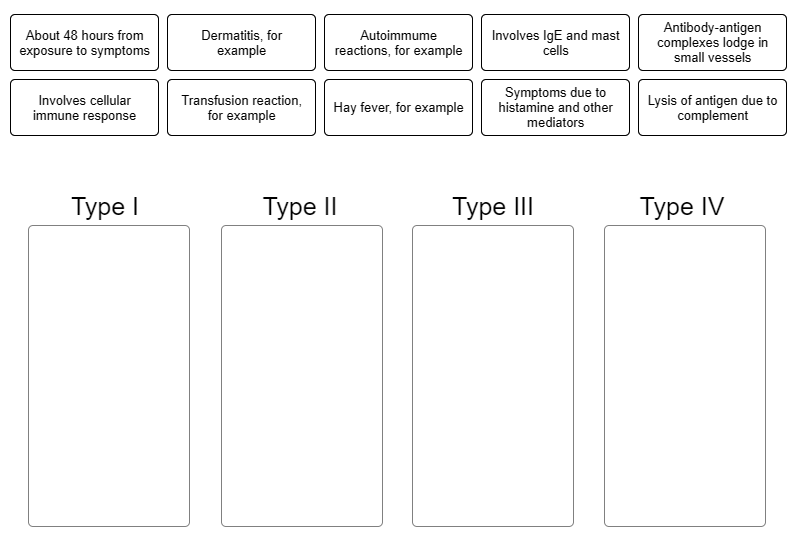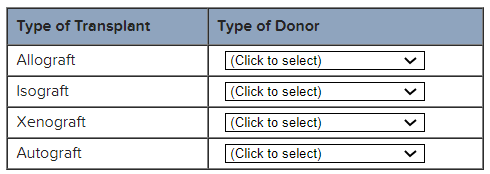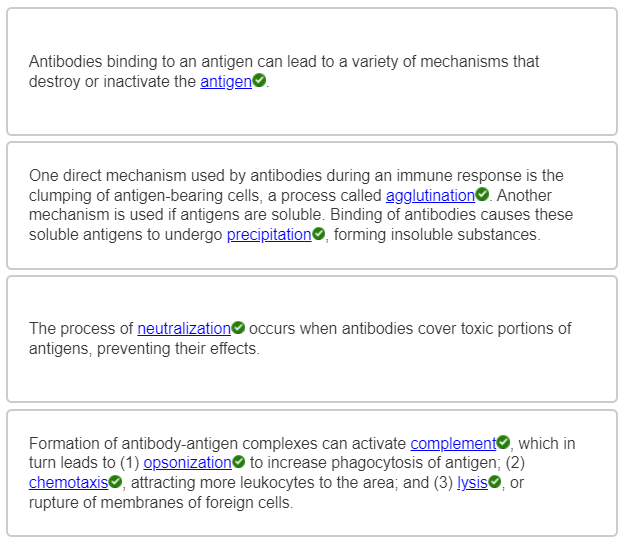The ______ receives lymph from the right side of the head, neck, and thorax, and from the right upper limb.
right lymphatic duct
Name the lymphatic system organ that shrinks and becomes non-functional with age.
Thymus
The filtering of lymph and the initiation of immune responses to foreign material are functions of what organ(s)?
Lymph nodes
Lymphatic nodules are encapsulated lymphatic organs.
No
lymphatic nodules are clusters of immune cells that lack a connective tissue capsule.
Which are the lymphatic organs of the oral cavity and pharynx?
Tonsils
Match each statement with the appropriate lymphatic structure.
(find the functions of lymph node, thymus, spleen)
Lymph node: Filters lymph; initiates immune responses
Thymus: Site of maturation of T lymphocytes
Spleen: Filters blood; initiates immune responses
Cytotoxic T cells mount an immune response against __________.
cells that display foreign proteins on their surface
Cytotoxic T cells produce __________ which creates holes in the cell membranes of target cells.
perforin
How do cytotoxic T cells recognize that a cell is infected with a virus and needs to be destroyed?
The presence of foreign (viral) proteins on the target cell surface.
The receptors on cytotoxic T cells bind to __________.
viral antigens and class I MHC.
Foreign substances that elicit an immune response are called __________.
antigens
Macrophages secrete __________ which then activates __________ .
interleukin-1 ; helper T cells
Cytotoxic T cells target and destroy __________.
infected "self" cells
Helper T cells stimulate the proliferation of __________.
cytotoxic T cells and B cells
The secondary immune response to a previously encountered pathogen is swifter and stronger than the primary immune response.
True
Complete the sentences describing the functions of the lymphatic system.
The lymphatic system is involved in the absorption of __________ from the digestive system.
fats
Label the features of the capillary and lymphatic bed.
This flow chart diagrams the series of structures involved in lymphatic drainage. Indicate the correct order of vessels.
Lymphatic capillary -> afferent lymphatic vessel -> lymph node -> efferent lymphatic vessel -> lymphatic trunk -> collecting duct -> subclavian vein
Complete the sentences describing tissue fluid and the formation of lymph.
Lymph drainage is important for what functions?
absorption of dietary fats,
return of small proteins from tissue fluid to blood,
transport of foreign particles from tissue fluid to lymph nodes
The absence or blockage of lymph vessels in a body region leads directly to what condition?
adema
This image shows a lymphatic vessel. The arrows indicate valves found in these vessels. Based on your understanding of the function of lymphatic valves, in which direction would lymph be flowing through the vessel shown?
From bottom of image toward top of image
Exercise is associated with an increase in lymph movement.
True
This figure shows the areas of lymphatic drainage. Correctly indicate the collecting duct that drains each area.
Lymph eventually is returned to the circulation at what blood vessels?
Right and left subclavian veins.
What is the role of skeletal muscle contractions in the flow of lymph?
skeletal muscles contraction compress lymphatic vessels, encourages the lymph to flow toward the upper thorax
Label the components of the sectioned lymph node.
Indicate where in the lymph nodes the listed cell types are found by dragging labels to the appropriate boxes. Some labels are used more than once.
List the function(s) of lymph nodes.
Filter lymph,
Immune surveillance,
In the cadaver image shown, name the group of lymph nodes highlighted in yellow.
Axillary lymph nodes
Label the clusters of lymph nodes.
For each description, indicate the correct group of lymph nodes.
In the cadaver image, identify the lymphatic structure highlighted in yellow.
Thymus
In this image of the abdominal cavity of a cadaver, name the structure highlighted in yellow.
Spleen
Label the thymus, spleen, and neighboring structures and organs.
Label the tissues and vessels of the spleen.
Label the regions within the spleen.
Classify each item as a feature of innate defense or adaptive defense.
The ______ defense mechanisms target specific pathogens.
In contrast, the more general defenses that protect against many types of pathogens are the _____ defense mechanisms.
adaptive
innate
Consider the types of defense. Drop each label into the flow chart to indicate whether it is a first, second, or third line of defense.
A chemical called endogenous pyrogen may be released from lymphocytes that are responding to a pathogen. What does this compound cause?
fever
Natural killer (NK) cells are what type of cell?
lymphocyte
Name the cells included in the mononuclear phagocytic system
Macrophages,
monocytes,
neutrophils
Match the description with the correct chemical barrier.
Name the innate defense that involves vasodilation and increased vascular permeability, resulting in the influx of blood, blood cells, and fluid to an area of injury or infection.
Multiple Choice
Inflammation
The figure illustrates the sites of lymphocyte precursor production, the site where T cells are processed, the site where B cells are processed, and an eventual location for the lymphocytes. Label each site.
Place the labels describing the locations of origin, development, and action of lymphocytes in the correct location on the figure.
Indicate the characteristics of the label is associated with B cells or T cells
Complete the sentences describing the types of T cells
Drag each label to the appropriate box to indicate if the label is associated with B cells or T cells
Indicate the cells that can function as antigen-presenting cells.
Dendritic cells, macrophages, and B cells
This figure illustrates the activation of B and T cells. Label the cells that are involved in the process.
This figure illustrates the process of stimulation and proliferation of B cells.
What term refers to any molecule that elicits an immune response?
Antigen
Cells such as macrophages can process foreign antigens and attach them to their cell surface in order to assist in activation of T cells. What are cells that have this function called?
Antigen-presenting cells
Place the events leading to T cell activation in the correct order.
Match the description with the correct type of cytokine.
Cell membrane proteins called ______ major histocompatibility complex (MHC) antigens are found on antigen-presenting cells, thymus cells, and activated T cells.
The _______ MHC antigens are found on membranes of all body cells, except red blood cells.
Class II
Class I
Class I MHC antigens are found in the membranes of_____ .
Class II MHC antigens are found in the membranes of ___________.
all body cells except RBCs
antigen-presenting cells, thymus cells, and activated T cells
The body is equipped with several mechanisms that function to prevent infection by pathogens. These mechanisms are referred to as the innate (nonspecific) defenses. They include mechanical and chemical barriers, phagocytic and natural killer cells, and the processes of inflammation and fever.
1. Interferons and complement proteins are examples of __________.
2. The changes that occur in infected or injured tissue (redness, swelling, heat, pain) are due to the process of __________.
3. Mechanical barriers include __________.
1. Chemical barriers
2. Inflammation
3. Skin and mucous membranes
The adaptive defenses are those responses by immune cells that target specific foreign antigens, with the purpose of destroying or inactivating the antigen. Review the roles of the various types of immune cells and answer the questions below. In the next activity, you will view an animation showing the steps in an immune response.
1. The primary cells of the immune response are the T and B cells. T and B cells are what type of cell?
2. Macrophages have a role in both innate and adaptive
defenses. What is the function of macrophages during infection by a
pathogen?
3. Phagocytic cells such as macrophages digest a
pathogen, then insert a bit of pathogenic antigen on their cell
membrane. In this role, these cells are described as being __________ cells.
1. Lymphocytes
2. To phagocytize the pathogen
3. Antigen-presenting
1. A macrophage that has phagocytized and displayed the antigen on
its surface is acting as a(n) __________.
2. Macrophages that are
displaying a pathogenic antigen will interact with __________ which
then continue the immune response.
3. Name the immune cell that
interacts with and kills an infected "self" cell.
4. B
cells are activated by (1) the binding of their antigen and (2)
interaction with __________.
5. What type of cell produces
antibodies?
6. Memory cells are involved in the __________ immune response.
1. Antigen-presenting cell
2. Helper T cells
3. Cytotoxic
cells
4. Helper T cells
5. Plasma cells
6. Secondary
Indicate whether the listed components of an immune response interact directly with an antigen, or if presentation of the antigen by an antigen-presenting cell is required. Labels may be used twice.
Complete the sentences describing the various classes of immunoglobulins, or antibodies.
Complete the sentences describing antibodies.
Fill in the blanks in the figure legend, indicating the identity of
the different colored segments of the antibody molecule.
Each label is used twice.
Drop each label into the appropriate box, indicating which class of immunoglobulin is being described. Some labels are used more than once.
What class of immunoglobulin is involved in immediate-reaction allergic reactions?
IgE
Memory T and B cells function in what type of response?
Secondary immune responseCorrect
The labels describe either a primary or secondary immune response. Drop each label into the appropriate bo
Immunity acquired with the injection of antibodies from another source is called ____
Immunity resulting when one's own immune system responds to an antigen encountered through normal routes is called______
Immunity in a newborn due to the passing of maternal antibodies through the placenta is called______
Immunity that occurs following vaccination with an antigen is called ______
artificially acquired passive immunity
naturally acquired active
naturally acquired passive
artificially acquired active

Complete the sentences describing the different types of immunity.

With aging, there is no decrease in the number B cells, and only a slight decrease in the number of T cells.
True
What is the first component(s) of the immune system to decline with age?
Thymus

Put the steps that occur during an immediate-reaction allergic response in the correct order.


Place the steps that occur during an immediate-reaction allergic response in the correct order.


Indicate characteristic into the appropriate box, describing each type of hypersensitivity.

What is another term for allergy?
Hypersensitivity

For each classification of transplant, indicate the correct type of donor.

Tissue rejection following a transplant resembles a __________ immune response.
Cellular
What term is used for disorders resulting from the immune system attacking "self" cells?
Autoimmune diseases
1. Indicate the order of cell types involved in the response to the
first exposure to an allergen.
2. Antibodies attach to mast cells
via what part of the antibody structure?
3. With second exposure
to an antigen, the antigen molecules bind to __________.
1. Antigen-presenting cell, helper T cell, B cell, plasma
cell
2. Constant region
3. IgE on the mast cells
1. In antibody-dependent cytotoxic allergic reactions (type II), the
binding of __________ to targeted cells results in lysis of those
cells.
2. Which of the following transfusions would result in an
antibody-dependent cytotoxic (type II) allergic reaction?
1. Antibodies
2. Type A blood given to a type B recipient
1. Immune complexes that are not removed by macrophages can react
with and activate __________.
2. The degranulation of cells
called __________ occurs in response to the activation of complement
by immune complexes. The result is __________ of blood vessels. This
leads to some of the symptoms of a type III hypersensitivity
reaction.
3. 3. The presence of the immune complexes and
complement attracts and activates neutrophils, causing them to
degranulate. What is the effect of neutrophil activation? (This effect
will also lead to some of the symptoms of a type III response.)
1. Complement
2. Basophils; vasodilation
3. Tissue damage
1. Delayed hypersensitivity is __________ mediated.
2. What type
of cell is responsible for contact dermatitis and tissue
rejection?
3. In a reaction to poison oak or poison ivy, a small
molecule from the plant, called a(n) __________, will bind to a host
molecule, triggering an allergic reaction.
4. What is presented
on the macrophage surface?
5. First exposure to the allergen
(hapten) causes an increase in the number of __________.
6. What
attracts additional macrophages and causes their release of mediators
of inflammation?
1. Cell
2. Th1 cells
3. Hapten
4. Hapten plus class II
MHC
5. Th1 cells
6. Release of cytokines from Th1 cells

Label the figure showing the pathway for lymphatic drainage from the right breast.

What is the name of the fluid contained within vessels of the lymphatic system?
Lymph

What is the name of the structure found in lymphatic vessels, indicated by the arrows?
Valve

Complete the sentences describing the process of inflammation.

When T or B cells are activated, they proliferate, forming a group of genetically identical cells descending from the original activated cell. What is the name of this group of identical cells?
Clone
A molecule called a(n) _______ is typically a large, complex molecule that stimulates an immune response.
A small molecule that can not stimulate an immune response on its own, but may cause an immune response when it binds to a larger molecule is called a(n).
antigen
hapten

Complete the sentences describing the actions of antibodies.

What type of immunity will result from receiving a vaccination?
Artificially acquired active immunity
Delayed-reaction allergic responses are mediated by B cells.
False
As lymph is returned to the blood, it enters the __________ circulation.
venous
What is inflammation?
Tissue response to injury or infection
What type of T cell does not respond to a foreign antigen on first exposure, but will respond rapidly upon subsequent exposure?
Memory cells
Lymphatic pathways begin at the lymphatic capillaries which empty into lymphatic vessels. From there, fluid flows through lymphatic __________ into lymphatic __________, eventually emptying into veins in the thorax.
trunks; ducts
What are lymphatic nodules?
Compact masses of lymphatic tissue
In order to be fully activated, most __________ cells require interaction with __________ cells.
B
T
Autoimmune Polyendocrinopathy Syndrome type 1 (APS-1) is a rare autoimmune disorder. Autoimmune diseases occur when the immune system attacks the cells of the body as if they were pathogens. In APS-1, a protein called AIRE, expressed in the thymus, is mutated. AIRE protein is part of the apparatus that presents self-antigens to T-cells in the medulla of the thymus. In APS-1, AIRE protein is mutated to the extent that it cannot perform its function.
1. What portion of T-cell maturation is impaired in
APS-1?
2. The T-cells of patients with AIRE could have which of
the following problems?
1. Negative selection
2. The T-cells will express all the
correct receptors, but may react with self-antigens.
1. Which of these cells produces IL-2?
2. What does a cytotoxic
T-cell release upon recognizing a virally-infected cell (assuming the
T-cell was previously activated with IL-2)?
3. Which of these
molecules is likely to be presented from the endogenous pathway?
1. Helper T cells
2. Granzymes
3. Viral capsid protein

Place these items in the correct sequence.

Which of these processes involves a phagocytic cell?
opsonization
Ebola is a virus that is transmitted through exchange of blood and other bodily fluids. Once the virus enters the body it resides inside of cells. During the Ebola outbreak of 2014-2015 there were no available vaccines or medications. Several patients were saved, however, by receiving blood plasma containing antibodies from patients who had been previously infected and survived.
1. Which of the following may have occurred in the Ebola
patients after the blood plasma and antibody transfusion?
2. Fc
regions are similar from one patient to another. Would phagocytic
cells be involved in clearing the Ebola virus from the patient recipient?
1. Ebola viruses will be neutralized as they become coated with
antibodies.
2. Yes, opsonization of the neutralized viruses is
likely to occur.
1. Which of these cells is capable of phagocytosis?
2. Which of
these chemicals aids in inducing apoptosis in a virally-infected
cell?
3. Which of these cell types is capable of producing
cytotoxic chemicals against a multicellular parasite?
1. Dendritic cells
2. Granzyme
3. Eosinophils
1. Which of the following is largely responsible for swelling during
inflammation?
2. Vasodilation and capillary permeability might be
helpful in an immune reaction because...
1. Histamine
2. Vasodilation and increased permeability allow
immune cells to exit the blood and fight bacteria in the tissues.
1. Which of the following is NOT an effect of interferons secreted by
an infected cell?
2. Which of these cells or organs plays a role
in destroying pathogens using complement?
3. Which of these
statements is TRUE about macrophages?
1. Interferons attach to viruses, resulting in destruction of the
pathogens.
2. The liver, macrophages, erythrocytes
3.
Macrophages phagocytose bacteria when they recognize complement
proteins on the bacterial surface.
1. Which of the following best describes the role of complement
protein C5b in the immune response?
2. What clinical symptoms do
you expect from patients with p.A252T homozygous mutations?
1. C5b helps form a complement protein complex on bacteria cells that
leads to their destruction.
2. An increase in frequency of
bacterial diseases such as meningitis and pneumonia